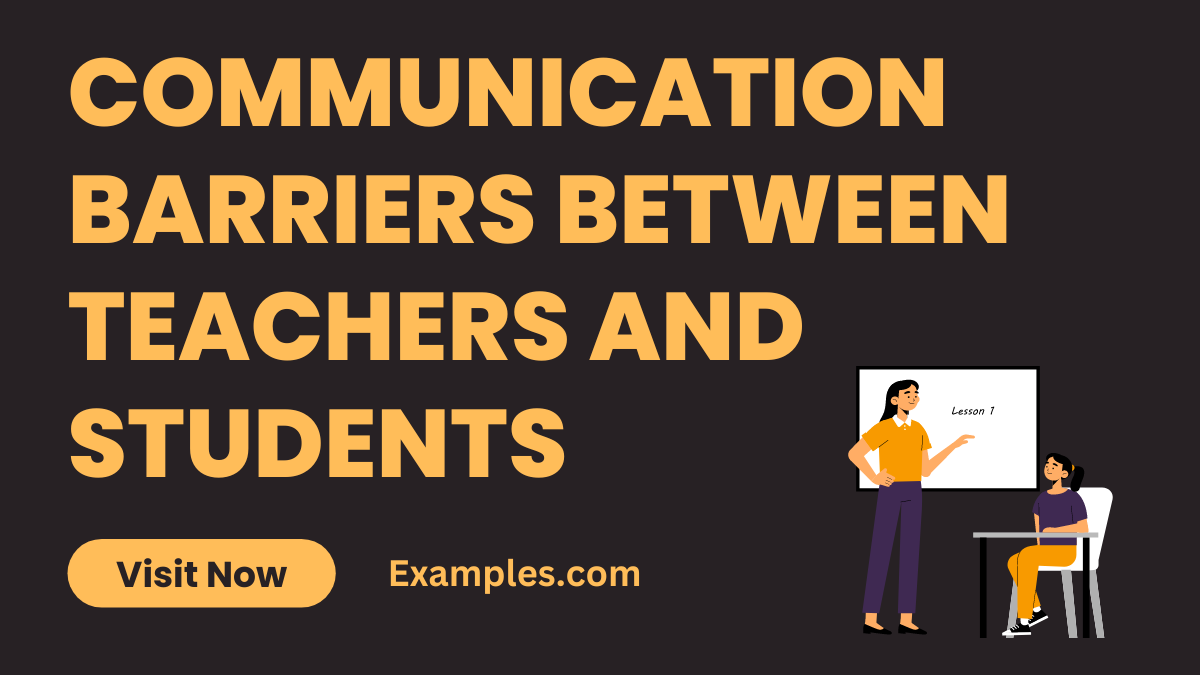19+ Communication Barriers Between Teachers and Students Examples
Embarking on a journey through the intricate landscape of teacher-student interaction, this comprehensive guide unveils the nuanced world of Communication Barriers Between Teachers and Students. Delve into illuminating examples that breathe life into theoretical concepts, offering a practical understanding of effective communication. Navigate through insightful tips and strategies, empowering both educators and learners to foster an environment where communication thrives. Welcome to a guide where theory meets reality, enriched with vivid “Communication Examples” to illuminate your path.
What is Communication Barriers Between Teachers and Students?
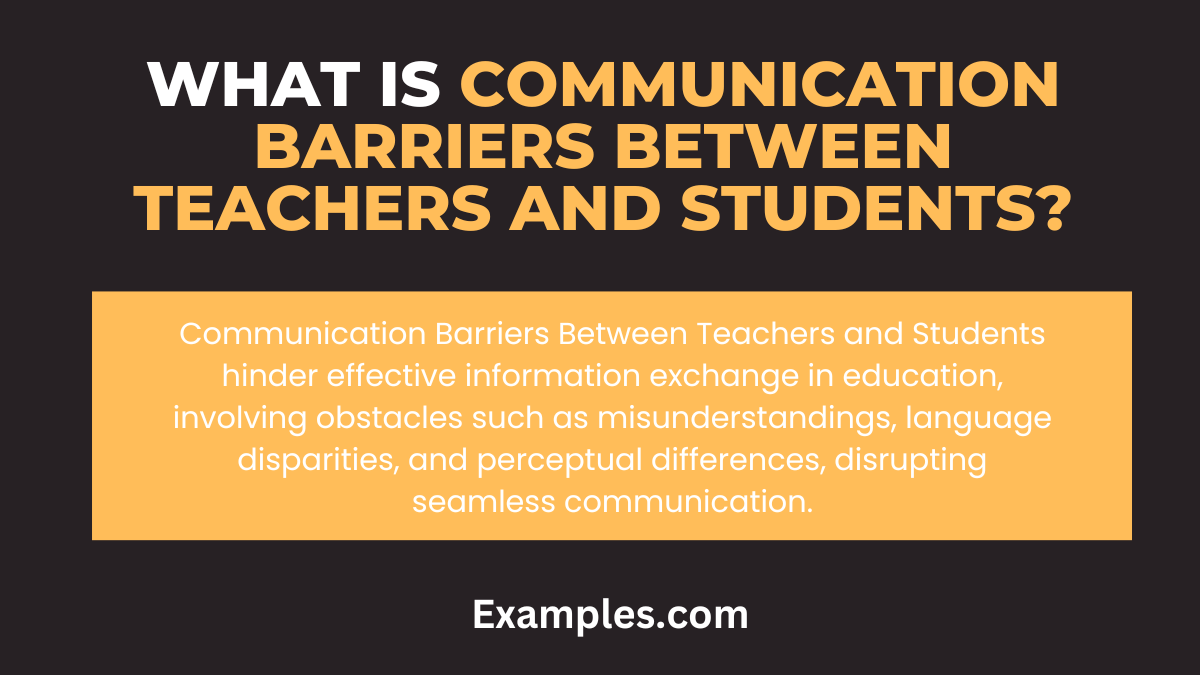
In simple terms, Communication Barriers Between Teachers and Students refer to obstacles that impede effective information exchange in educational settings. These hindrances can include misunderstandings, language disparities, or perceptual differences, disrupting the seamless flow of communication between educators and learners. This H2 heading aims to demystify the complexities, providing a clear and straightforward definition for a better understanding of communication hurdles in the educational domain.
What is the Best Example of Communication Barriers Between Teachers and Students?
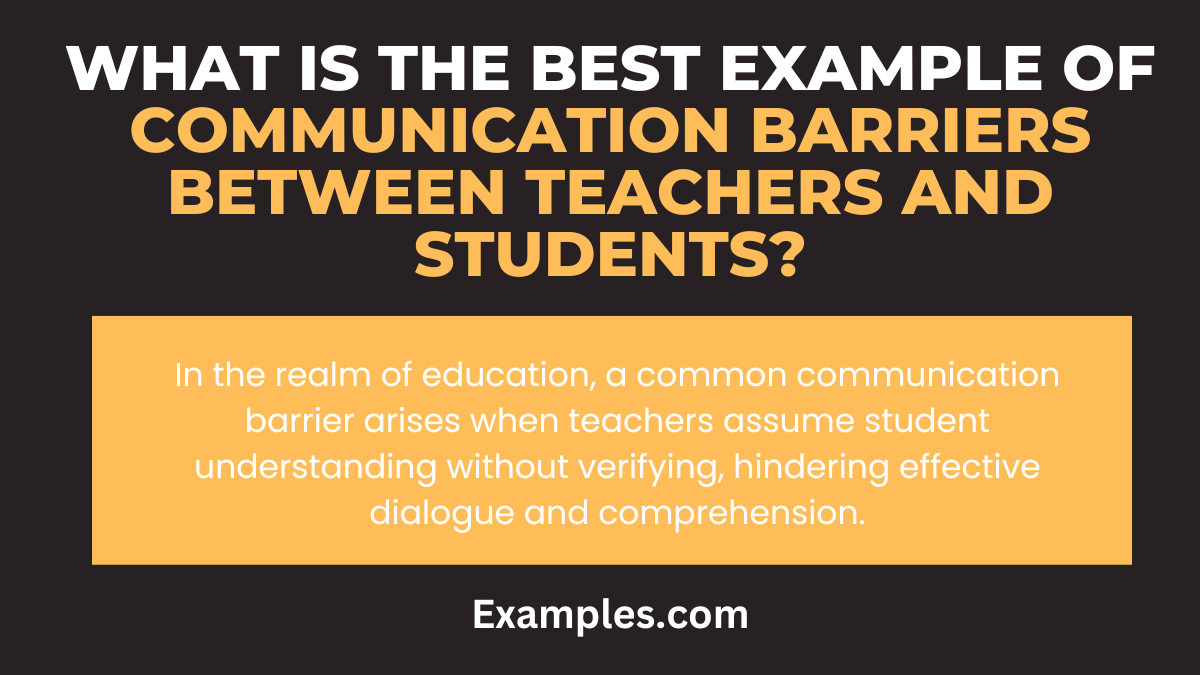
In a vivid illustration of communication barriers, imagine a student struggling with a complex math concept. The teacher, unknowingly, uses technical jargon and assumes prior understanding. The student, feeling hesitant to ask for clarification, nods in apparent comprehension. This misalignment in understanding exemplifies a common barrier, where assumptions and hesitancy hinder effective teacher-student communication. Explore this detailed analysis for insights into overcoming such instances and fostering clearer educational communication.
20 Communication Barriers Between Teachers and Students Examples
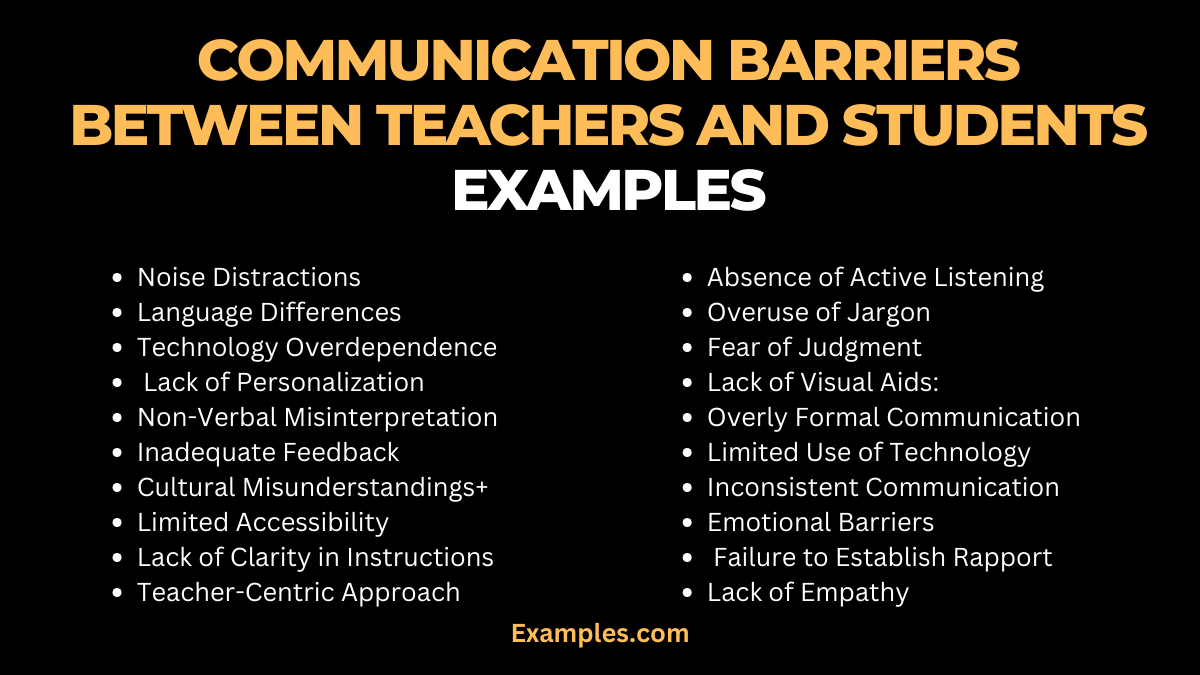
Communication barriers in the teacher-student dynamic can impede the learning process. This guide explores such obstacles, providing a concise description for each, followed by a bold example and a brief explanation. By addressing these barriers, educators can enhance communication and create a more conducive learning environment.
1. Noise Distractions: Excessive classroom noise disrupts communication.
Example: Despite background chatter, the teacher ensured clarity by using concise and bold instructions.
2. Language Differences: Diverse language backgrounds can lead to misunderstandings.
Example: In a multilingual class, the teacher employed visual aids for clearer comprehension.
3. Technology Overdependence: Reliance on gadgets may hinder face-to-face interaction.
Example: Instead of screens, the teacher encouraged hands-on activities to foster engagement.
4. Lack of Personalization: Generic communication may alienate students.
Example: The teacher personalized feedback, addressing individual learning styles for better understanding.
5. Non-Verbal Misinterpretation: Body language can be misunderstood.
Example: The teacher clarified intentions, avoiding non-verbal cues that could lead to confusion.
6. Inadequate Feedback: Insufficient feedback hampers student improvement.
Example: Providing constructive criticism, the teacher guided students toward enhanced performance.
7. Cultural Misunderstandings: Diverse backgrounds require cultural sensitivity.
Example: To bridge gaps, the teacher integrated culturally relevant examples into lessons.
8. Limited Accessibility: Physical barriers can hinder communication.
Example: Ensuring an accessible classroom, the teacher accommodated students with diverse needs.
9. Lack of Clarity in Instructions: Ambiguous instructions lead to confusion.
Example: Employing concise language, the teacher clarified complex concepts for easy understanding.
10. Absence of Active Listening: Failing to actively listen impedes understanding.
Example: The teacher practiced attentive listening, fostering a responsive and engaged classroom.
11. Overuse of Jargon: Complex terminology may overwhelm students.
Example: Avoiding jargon, the teacher explained concepts using relatable language.
12. Fear of Judgment: Students may hesitate due to fear of judgment.
Example: Creating a non-judgmental environment, the teacher encouraged open dialogue.
13. Lack of Visual Aids: Visual learners benefit from supportive materials.
Example: Incorporating visuals, the teacher reinforced concepts for visual learners.
14. Overly Formal Communication: Being too formal may create a barrier.
Example: Adopting a friendly tone, the teacher connected with students on a personal level.
15. Limited Use of Technology: Failing to leverage tech tools can hinder engagement.
Example: Integrating interactive apps, the teacher enhanced student participation.
16. Inconsistent Communication: Inconsistency breeds uncertainty.
Example: Maintaining regular updates, the teacher kept students informed about upcoming assignments.
17. Emotional Barriers: Emotional challenges affect communication.
Example: Addressing emotional concerns, the teacher created a supportive space for expression.
18. Lack of Empathy: Understanding student perspectives is crucial.
Example: Demonstrating empathy, the teacher acknowledged and addressed students’ concerns.
19. Failure to Establish Rapport: A positive teacher-student relationship fosters communication.
Example: Building rapport, the teacher created a trusting and open classroom environment.
20. Teacher-Centric Approach: A one-sided approach stifles student engagement.
Example: Adopting a student-centered approach, the teacher encouraged active participation and collaboration.
Communication Barriers Between Teachers and Students in the classroom Examples
Effective classroom communication is essential for learning. However, various barriers can hinder this process. Overcoming these challenges ensures a conducive learning environment.
- Limited Interactive Activities: Example: The teacher organized group discussions, promoting active participation and breaking the barrier of passive learning.
- Inadequate Feedback Loop: Example: Implementing regular feedback sessions, the teacher addressed students’ queries promptly, enhancing the feedback loop.
- Unclear Expectations: Example: Providing clear assignment guidelines, the teacher eliminated confusion and improved student performance.
- Use of Unfamiliar Technology: Example: Introducing user-friendly apps, the teacher facilitated tech-savvy communication, overcoming resistance to unfamiliar tools.
- Language Barriers: Example: Employing simple language, the teacher accommodated diverse linguistic backgrounds, fostering inclusive communication.
Communication Barriers Between Teachers and Students at School Examples
School-wide communication is crucial for a holistic learning experience. Identifying and addressing barriers at this level ensures a collaborative and supportive educational environment.
- Ineffective Parent-Teacher Communication: Example: Establishing regular communication channels, the school improved parent-teacher engagement, fostering a collaborative learning environment.
- Lack of Inclusive Policies: Example: Implementing inclusive policies, the school created an environment that catered to diverse student needs and backgrounds.
- Inaccessible Resources: Example: Ensuring accessibility, the school provided resources in various formats, addressing diverse learning needs.
- Bullying and Peer Pressure: Example: Implementing anti-bullying programs, the school addressed behavioral issues, promoting a safe and supportive atmosphere.
- Insufficient Mental Health Support: Example: Introducing counseling services, the school provided a platform for students to address mental health concerns, breaking down communication barriers.
What are the barriers of effective communication between students and teachers?
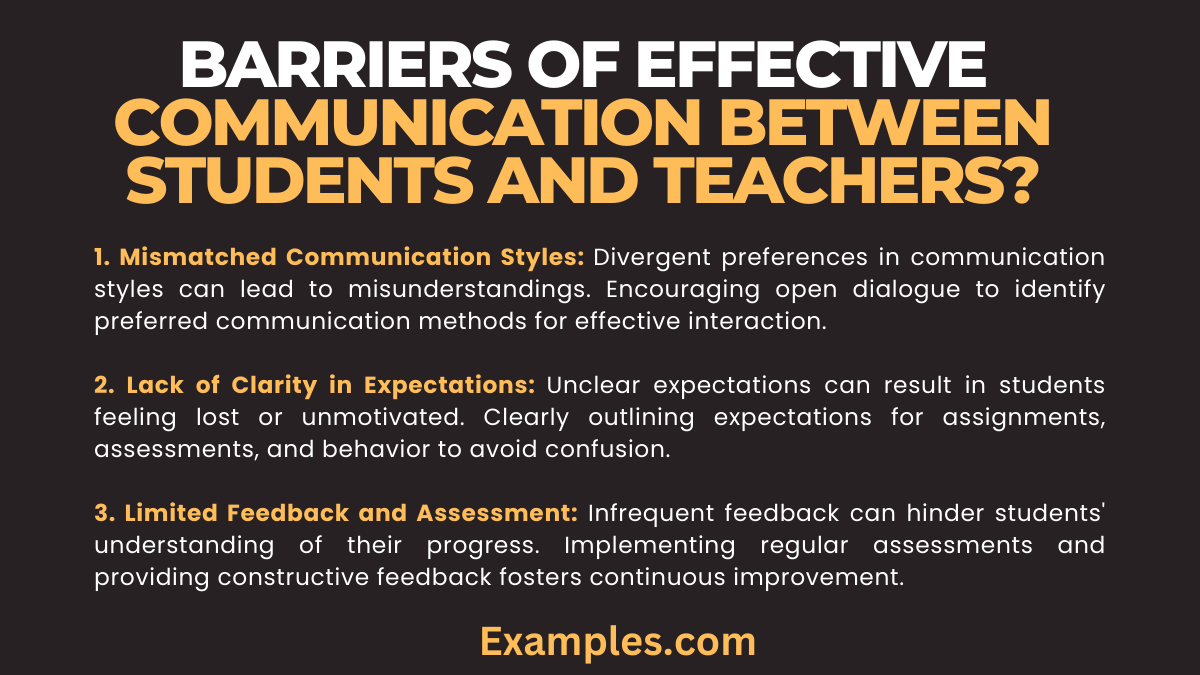
Establishing effective communication in the educational setting is crucial for successful teaching and learning experiences. However, various barriers can impede this communication, affecting the overall academic environment. Here’s an in-depth exploration of the key barriers between students and teachers.
1. Mismatched Communication Styles: Divergent preferences in communication styles can lead to misunderstandings. Encouraging open dialogue to identify preferred communication methods for effective interaction.
2. Lack of Clarity in Expectations: Unclear expectations can result in students feeling lost or unmotivated. Clearly outlining expectations for assignments, assessments, and behavior to avoid confusion.
3. Limited Feedback and Assessment: Infrequent feedback can hinder students’ understanding of their progress. Implementing regular assessments and providing constructive feedback fosters continuous improvement.
4. Language and Cultural Barriers: Varied language proficiency and cultural backgrounds can create communication gaps. Promoting a multicultural environment, using clear language, and offering language support when needed.
5. Technology-Related Challenges: Unequal access to technology or unfamiliarity with digital tools can impede communication. Ensuring equitable access to technology and providing training for both teachers and students.
6. Lack of Personal Connection: Limited personal connections can hinder trust and understanding. Encouraging relationship-building through open discussions, mentorship, or extracurricular activities.
7. Classroom Distractions: External disruptions can impact students’ focus and attention. Implementing strategies to minimize distractions and create an engaging learning environment.
8. Insufficient Support Services: Inadequate access to support services may hinder students facing challenges. Establishing and promoting support services, such as counseling and tutoring, to address individual needs.
By addressing these barriers proactively, educators and students can create a more inclusive and effective learning environment, fostering improved communication and enhancing the overall educational experience.
What is the impact of communication between the teacher and student?
In summary, the impact of communication between teachers and students is profound, influencing academic achievement, emotional well-being, and the development of essential life skills. By recognizing and addressing communication barriers, educators can optimize these impacts, creating a positive and enriching learning environment.
1. Academic Performance: Effective communication positively correlates with academic success. Clear instructions, timely feedback, and an open dialogue contribute to enhanced understanding, leading to improved grades and performance.
2. Motivation and Engagement: Communication plays a pivotal role in fostering student motivation and engagement. Inspirational messages, personalized feedback, and encouraging interactions contribute to a positive attitude toward learning.
3. Classroom Atmosphere: The quality of communication shapes the overall classroom atmosphere. Positive and constructive interactions create a conducive environment for learning, while misunderstandings or lack of communication may result in a negative atmosphere.
4. Student Confidence: Clear and supportive communication boosts students’ confidence. Regular feedback, acknowledgment of achievements, and open communication channels contribute to a sense of accomplishment and self-assurance.
5. Emotional Well-being: Effective communication addresses students’ emotional needs. A supportive teacher-student relationship can act as a buffer against stress, anxiety, and other emotional challenges, promoting overall well-being.
6. Behavioral Development: Communication guides students in understanding behavioral expectations. Clear communication about rules, expectations, and consequences helps shape positive behavior and encourages responsible conduct.
7. Personalized Learning: Tailored communication allows for personalized learning experiences. Understanding individual student needs, preferences, and learning styles enables teachers to customize their approach, ensuring a more effective learning journey.
8. Teacher-Student Relationship: Communication is foundational to building strong teacher-student relationships. Open lines of communication foster trust, respect, and a collaborative partnership between educators and students.
In conclusion, navigating and mitigating communication barriers between teachers and students is pivotal for fostering a positive and effective learning environment. By understanding, addressing, and fostering open communication, educators can enhance student engagement, academic success, and overall well-being. This comprehensive guide equips both teachers and students with valuable insights to cultivate meaningful connections and optimize the learning experience.



